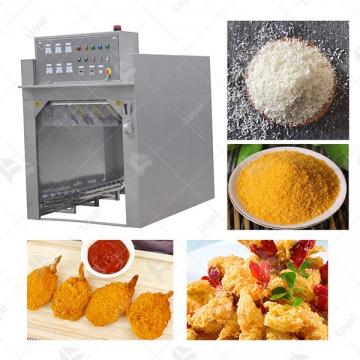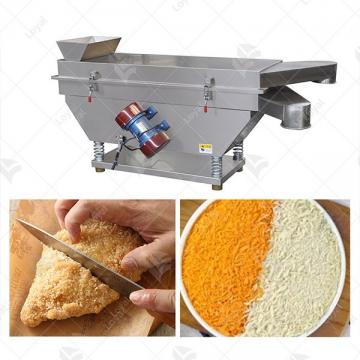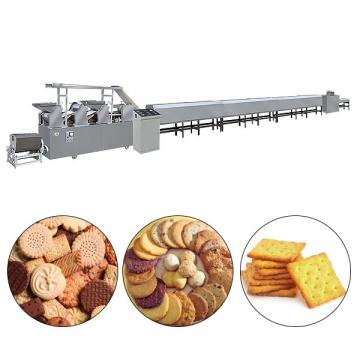
- Shandong Loyal Industrial Co.,Ltd.
- Macaroni Production Machine Instant Noodle Machine Biscuit Making Machine
Home> Processing> Discovering The World Of Macaroni Production Line

Discovering The World Of Macaroni Production Line
2025-06-20 17:43:50If you want to know more story about LOYAL brand, here can help you - https://www.facebook.com/foodmachineloyal
Pasta Introduction
Pasta, one of the most popular staple foods in the world, originated in Italy and has now entered tables around the world. Whether it is a family meal or a high-end Western meal, pasta is well-loved for its rich variety, diverse flavors and convenient cooking methods.
1.Definition of pasta
Pasta is a kind of pasta made by mixing wheat flour (mostly durum wheat, also known as durum wheat Semolina) and water, and then kneading, shaping, drying and other processes. Some pasta recipes also add eggs, vegetable powder or seasonings to make its taste and color more diverse.
Pasta can be made fresh or dried , which is easy to store and transport. It is an important food choice for modern families and the catering industry.
2. Common types of pasta
There are many types of pasta, and different shapes and uses allow it to adapt to various cooking needs. Common types include:
Spaghetti: a classic long and round pasta suitable for a variety of sauces.
Macaroni: short, hollow tubes of pasta, good for gratin or salad.
Fusilli: spirals absorb sauces.
Penne: have diagonal cuts for a fuller texture.
Farfalle: unique shapes, often used for cold dishes and children’s meals.
Lasagna: large sheets that can be stacked and baked.
3.Nutritional value of pasta
Pasta is a high-quality source of carbohydrates, providing energy, and also contains a certain amount of protein. If whole wheat flour is used or vegetable ingredients are added, the dietary fiber and vitamin content is higher. Paired with meat, cheese, vegetables, olive oil, etc., it can form a balanced and healthy meal.
Pasta Market
Macaroni is no longer just a staple of Italian cuisine—it's a global phenomenon. As consumer demand grows for healthy, versatile, and convenient foods, macaroni products like macaroni are increasingly featured on supermarket shelves, restaurant menus, and in ready-to-eat meals. To keep up with this rising demand, food manufacturers are turning to advanced macaroni making machine that combine industrial power, intelligent automation, and adaptable designs.
Whether you’re a food industry newcomer or an established manufacturer, selecting the right macaroni processing line can be the difference between rapid success and ongoing production challenges. In this article, we’ll guide you through the core features and advantages of modern macaroni production machinery—and how it can boost your efficiency, product quality, and return on investment.

Working Process of the Macaroni Manufacturing Line
1.Powder Mixer
The powder mixer serves to thoroughly blend the essential ingredients—such as flour, water, salt, and various additives—according to specific formulations required for macaroni production. This equipment ensures a uniform and consistent dough mixture with optimal moisture and viscosity, which is crucial for maintaining stable product quality throughout the subsequent processing steps.
2.Hoister
This machine is utilized to lift the prepared dough from a lower level to a higher point, typically feeding it into the vacuum extrusion system. By enabling vertical transportation, the hoister streamlines material flow, reduces the need for manual handling, and supports uninterrupted operation along the production line.
3.Vacuum Extruder
Functioning as a pivotal piece of machinery, the vacuum extruder shapes and compacts the dough while operating under vacuum conditions. The removal of internal air during extrusion enhances the density, elasticity, and surface smoothness of the macaroni, significantly reducing issues like air bubbles and ensuring a more visually appealing and better-textured product.
4.Vibrating Feeder
This device facilitates the steady and uniform transfer of extruded macaroni toward the next processing phase, typically the circulating oven. Its vibration-based design prevents clumping or blockages, promoting evenly spaced product flow that results in consistent drying and enhanced output quality.
5.Circulating Oven
The circulating oven plays a critical role in drying and baking the macaroni using a controlled hot air system. By distributing heat evenly, it efficiently removes residual moisture, helping the product reach the desired water content level. This step not only prolongs shelf life but also contributes to the macaroni's final flavor and firm texture.
6.Cooling Conveyor
Once out of the oven, the high-temperature macaroni is gently cooled down using a conveyor system that relies on natural airflow or forced ventilation. This process lowers the temperature to suitable levels for handling and packaging, while also preventing warping, clumping, or surface damage, thus ensuring product integrity is maintained before storage or distribution.
Technical Parameters Of Macaroni Production Line
|
Item No. |
Capacity (kg/h) |
Power(kw) |
Size (L*W*H) |
|
GY-100 |
100kg/h |
12kw |
1200x800X1500mm |
|
GY-200 |
200kg/h |
22kw |
1500x1000X1800mm |
|
GY-300 |
300kg/h |
30kw |
2300X3000X4200mm |
|
GY-500 |
500kg/h |
37kw |
2700X3000X4200mm |
|
GY-1000 |
1000kg/h |
75kw |
4000X3500X5200mm |
|
GY-2000 |
2000kg/h |
90kw |
4500X3500X5200mm |
What Makes a Macaroni Processing Equipment Industrial-Grade?
A true industrial macaroni line is more than just a machine—it’s a solution. It’s designed not only to produce large volumes but also to maintain quality and reduce operational risks over time. Here's what defines industrial-grade equipment:
1.Heavy-Duty Construction
Top-performing macaroni macaroni machines are built with premium stainless steel and reinforced frames. This ensures stability during high-speed operations and resistance to corrosion, moisture, and wear. Every part, from the dough feeder to the extruder and drying tunnel, is engineered to handle 24/7 continuous use without compromising hygiene.
2.High Output Capacity
Production capacity is often a deciding factor. Commercial macaroni lines can output anywhere from 300 kg/h to over 2,000 kg/h depending on the configuration. This is critical for businesses serving large-scale retail chains, foodservice providers, or exporting macaroni internationally.
3.Compliance With Food Safety Standards
Modern macaroni manufacturing equipment must comply with rigorous global standards such as CE and ISO 9001. Sanitary design features like easy-access cleaning ports, food-safe coatings, and sealed chambers ensure that your production not only meets regulations but also earns customer trust.
By investing in industrial-grade machinery, food businesses ensure not only speed but also consistency, traceability, and compliance—all essential for scaling production safely and sustainably.

User-Friendly Controls: Making Operations Easier
One of the most transformational shifts in macaroni manufacturing is the rise of smart control systems. These innovations make managing a macaroni extrusion line easier than ever before.
1.Advanced PLC Touch Panels
With intuitive touchscreen interfaces, operators can monitor all stages—mixing, extrusion, shaping, drying, and cooling—in real-time. These systems offer customizable recipes, automatic error detection, and parameter adjustments that can be made with a single tap.
2.Automation Enhances Precision
Precision is critical in macaroni production. Too little water or an incorrect drying time can affect the texture and shelf life. Thanks to integrated sensors and automation, today’s macaroni processing systems maintain strict control over temperature, humidity, and pressure across every zone of the production line.
3.Operator-Friendly Interfaces
Gone are the days of relying solely on skilled technicians. Newer machines require minimal training and offer multilingual support, built-in safety alerts, and remote assistance options. Even new staff can operate the line confidently within a short time.
Together, these user-friendly features reduce errors, improve uptime, and increase overall process transparency.
Flexible Configuration: Adapting to Your Production Needs
Flexibility is essential in a fast-moving food market where customer preferences evolve rapidly. A modern macaroni production plant should be able to switch easily between products, packaging formats, and output levels.
1.Multiple macaroni Shapes from One Line
Thanks to interchangeable dies and variable cutters, a single macaroni extrusion system can produce macaroni, penne, rigatoni, and more—simply by swapping components. This allows manufacturers to respond quickly to changing consumer demands without costly downtime.
2.Custom Drying and Cooling Systems
Drying is a delicate stage. Too fast and the macaroni cracks; too slow and it becomes soft or sticky. Flexible macaroni drying solutions allow programmable heat zones, airspeed control, and moisture profiling. This leads to consistent quality across batches, even when switching shapes or ingredients.
3.Integration and Scalability
Your macaroni production line should grow with your business. Modular designs enable seamless integration with upstream mixers and downstream packaging systems. And when it’s time to scale up, you can expand output by adding extruders or drying tunnels—without replacing the entire setup.
With flexible configurations, manufacturers can balance product variety, quality, and efficiency—all from a single line.

Benefits of Choosing a High-Quality Macaroni Production Line
Choosing a high-performance macaroni line may seem like a big investment, but the long-term gains are significant:
1.Reduced Downtime and Repairs
Well-designed machines experience fewer breakdowns, reducing the need for maintenance and minimizing production disruptions. This keeps operations running smoothly and reduces operating costs.
2.Increased Productivity
Automated functions—like recipe loading, ingredient dosing, and cutting—mean your staff can focus on oversight rather than manual operation. This boosts throughput and reduces the number of workers needed per shift.
3.Enhanced Product Consistency
With programmable controls and sensor-based adjustments, automatic macaroni machines ensure every batch meets uniform size, shape, and cooking time standards.
4.Energy and Cost Efficiency
Energy-efficient components and intelligent drying systems help lower utility bills. Combined with fewer labor requirements and less material waste, the ROI becomes clear within the first year of operation for most facilities.
By investing in top-quality equipment, macaroni producers secure not only profitability but also a strong competitive edge.
Applications Across the Food Industry
The versatility of a macaroni making line makes it ideal for various sectors in the food industry:
Dry macaroni Manufacturers: Large-scale facilities producing boxed macaroni for retail.
Ready-Meal Brands: Pre-cooked or semi-cooked macaroni used in frozen meals and instant macaroni kits.
Food Exporters: Production lines tailored to meet packaging, certification, and quality standards across regions.
Catering & Institutional Food Suppliers: Quick-cook macaroni for restaurants, schools, and hospitals.
Each of these sectors benefits from the consistency, efficiency, and flexibility that a modern macaroni production system provides.
Choosing the Right Manufacturer
Your choice of macaroni line supplier is just as important as the equipment itself. Here’s what to evaluate:
1.Industry Expertise
Look for manufacturers with deep experience in food machinery. Case studies, references, and installations in diverse markets are strong indicators of reliability.
2.Custom Engineering Services
Not all macaroni operations are the same. Whether you're working with rice flour, semolina, or gluten-free blends, your supplier should offer custom-built macaroni systems to suit your ingredients and production goals.
3.Technical Support and Training
After-sales support, remote troubleshooting, and spare parts availability are critical to long-term success. A manufacturer who offers full lifecycle support—from installation to operator training—adds tremendous value.
By partnering with a reputable, knowledgeable company, you secure not just machinery, but a long-term solution provider.
Conclusion
In today’s fast-paced food processing world, the demand for efficiency, quality, and scalability has never been higher. A modern macaroni manufacturing line provides exactly that—industrial-grade strength, intuitive controls, and flexible configurations that adapt to your specific needs.
Whether you're producing macaroni for local supermarkets or exporting macaroni worldwide, choosing the right equipment will streamline your workflow, reduce costs, and elevate your brand.
Investing in a high-quality macaroni production system is not just a purchase—it’s a strategic step toward building a more competitive and future-ready food manufacturing business.
Why choose us
We are a professional manufacturer of food machinery and we have been manufacturing nutrition cereal bar processing line for nearly 20 years. In addition to the Nutrition Cereal Bar snack processing line, we also manufacture lines for deep-fried food, pet feed, modified starch and many more. Each of our lines has basically a variety of moulds, which can be adapted to produce a wide range of food products. We are not satisfied with the status quo but are constantly upgrading and innovating our products, adapting our production plans and designs to the changing needs of the times and keeping up with the pace of progress. Never satisfied with the pursuit of excellence!

Reference
The following are five authoritative foreign literature websites in the field of Industrial food machinery:
1. Food Engineering Magazine
Website: https://www.foodengineeringmag.com/
2.Food Processing Magazine
Website: https://www.foodprocessing.com/
3.Journal of Food Engineering
Website:https://www.journals.elsevier.com/journal-of-food-engineering
4. Food Manufacturing Magazine
Website:https://www.foodmanufacturing.com/
5. International Journal of Food Science & Technology
Website:https://onlinelibrary.wiley.com/
 Commercial Japanese Panko Bread Crumb Grinder Machine
Commercial Japanese Panko Bread Crumb Grinder Machine Japanese Bread Crumbs Processing Line
Japanese Bread Crumbs Processing Line Automatic Cookies Making Machines
Automatic Cookies Making Machines Fully Automatic Biscuit Making Machines
Fully Automatic Biscuit Making Machines